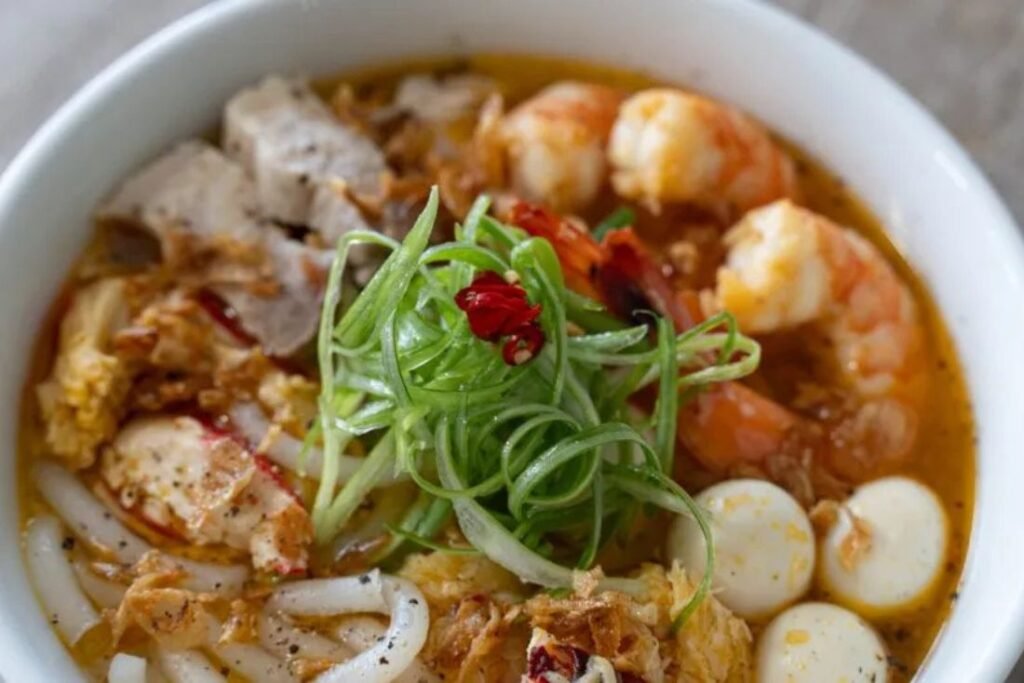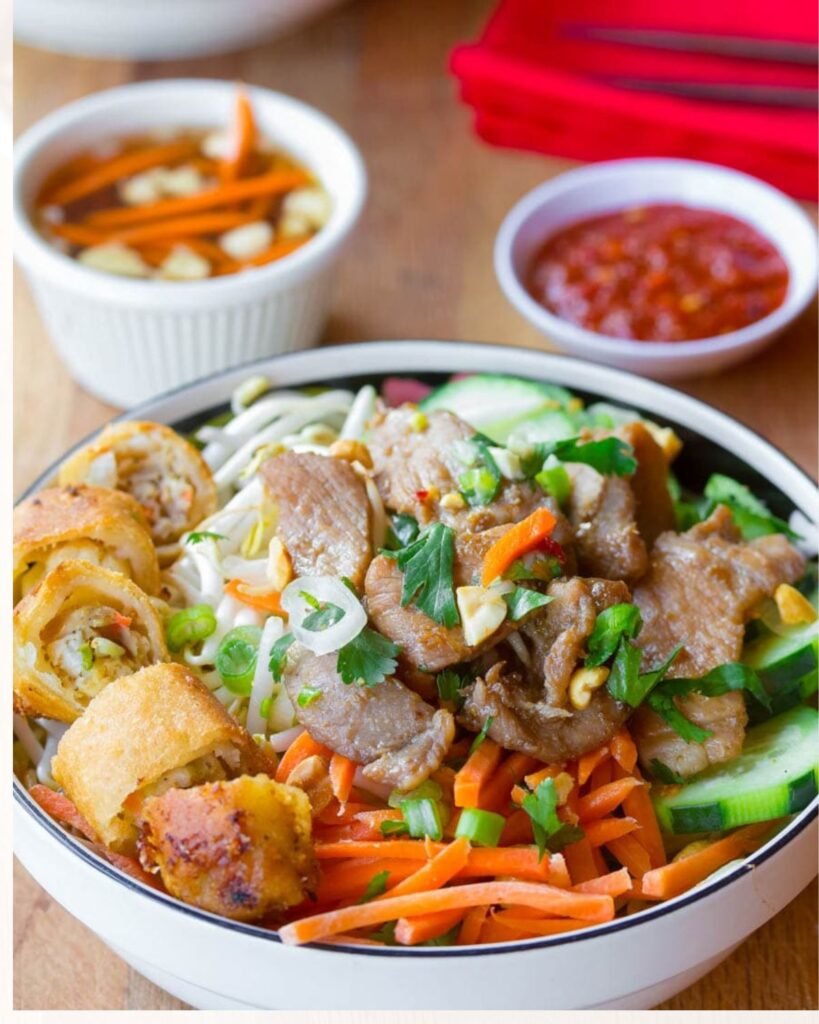When I was young, I remember bright bowls of bánh canh cua at festivals. The soup glowed red and orange from annatto oil and seed. It was bold and beautiful, and it felt like a party in a bowl.
I watched my mom make the broth with care. She always kept the crab taste strong. She added pork bones to make the stock rich and deep. The smell filled the air. Neighbors walked over, drawn by the aroma, to the church stalls. Volunteers sold steaming bowls to raise funds for local groups.
Later, I learned to cook the dish myself. The noodles are thick and chewy. They are not like the soft sweetness of Vietnamese Fruit Dessert. They are not as clear as Vietnamese Opo Squash Soup (Canh Bầu Tôm). Each bite feels full and firm. The crab meat is sweet, the shrimp give more bite, and green onions bring brightness. Cilantro adds a fresh lift. Fried shallots give crunch. As a child, I skipped chopsticks. I grabbed a spoon and slurped the broth until the bowl was empty.
Cooking this soup also showed me how dishes connect. The way tapioca starch makes the noodles thick reminds me of Udon Carbonara. It has the same soft pull, though the flavor is very different. The warmth of the soup feels like Vietnamese Winter Melon Soup (Canh Bí Sườn) or Vietnamese Macaroni Soup (Súp Nui). At home, we often ended meals with Vietnamese yogurt (Sữa chua). I still think of those meals when I share hot bowls of this soup with family.
Every part adds its own story. Crab roe makes the broth rich. Crab tomalley deepens the flavor. Even prepacked crab pieces can work when fresh crab is hard to find. Together, these parts turn bánh canh cua into more than a noodle dish. It is a taste of childhood, memory, and tradition.
What is Bánh Canh Cua?
The recipe is popular in Vietnamese homes and at festival stalls. I remember the church host during hội hè chợ in summer. Stalls and vendor teams served steaming bowls in styrofoam takeout cups.
Kids like me skipped chopsticks, grabbed a spoon, and just slurped the stock. The round noodles or thick Banh Canh noodles made from rice flour were fun to eat. Some bowls had whole shrimp, whole crabs, or fish balls. Others had blood cake, quail eggs, or crispy Chinese fried dough (Youtiao).
These toppings made each dish feel special. Every bowl felt like homage to tradition.
For me, this thick Vietnamese noodle soup is more than a dish. It is tied to childhood and fond memories of playing games, snacks, and eating while my mom volunteered with the community. The orange color that imparts warmth became a bright sign of joy.
Even now, I feel hooked on its texture. The slightly sticky, chewy bite comes from tapioca starch or a tapioca starch slurry. These thicken the noodle soup.
Whether made at home or bought from local businesses trying to raise money, every bowl I’ve had feels filled with care. It may be the older sibling of other soups like phở, yet it is particularly special. The variations make it arguably the most comforting.
Why You’ll Love This Vietnamese Crab Udon
Authentic Vietnamese flavors – This noodle soup brings out the sweet taste of fresh crab meat, the smooth feel of a tapioca-based broth, and the soft chew of thick udon-style noodles. It has the same balance I enjoyed in Southern Vietnamese seafood soup shops, and now you can enjoy it at home.
Nutritious & balanced – You get protein from crab, collagen from pork bones, and vitamins from scallions and cilantro. When I cooked this for my family, they loved that it was filling but still light. It is comfort food that does not feel heavy.
Restaurant-quality at home – No need to travel to Saigon street food stalls or pay extra in a Vietnamese restaurant. With simple steps, you can make a bowl of bánh canh cua at home. The taste is rich and close to what I had on my first trip to Ho Chi Minh City.
Customizable toppings – Try quail eggs, shrimp, Vietnamese fried shallots, lime wedges, or chili paste. I like to mix soft and crunchy toppings, it makes each bowl special. It works well for family meals or for parties.
Comfort food with cultural roots – This is one of Vietnam’s most loved seafood noodle soups. For me, it brings back times when I ate with friends by the coast. Each bowl carries tradition, heritage, and comfort. It is more than food, it is culture in a dish.
Beginner-friendly with expert tips – New to Vietnamese soups? Don’t worry. I share details on ingredients, swaps, and cooking steps to guide you. You will feel like a local chef and see why this soup is special in Vietnamese cuisine.
Ingredients, Substitutions & Adjustments
- Protein
For the broth, I always start with pork shoulder or chicken as the main meat. Three crabs and shrimp add a rich seafood umami that makes each bite special. Using bones from pork or chicken gives the broth more depth and warmth. Sometimes I try a different cut of meat to see how it changes the flavor—it’s a simple tip that really improves the taste.
- Vegetables & Aromatics
Adding yellow onion, white onions, and daikon brings natural sweetness and flavor to the broth. Over the years, I have substituted other vegetables depending on what is fresh. It works well and keeps the dish authentic. I like showing friends how easy it is to adapt the recipe while keeping the true taste.
- Broth & Seasoning
I use broth powder, chicken broth powder, chicken bouillon, or 1 can chicken broth to make the broth rich, balanced, and flavorful. Fish sauce adds umami, and vegetable oil or annatto oil gives a bright orange color and subtle sweetness. Simmering the broth slowly keeps a thick sticky texture, which makes this noodle soup taste just like the ones I grew up enjoying at family gatherings.
- Noodles & Thickener
I prefer Banh Canh noodles, but noodles made from tapioca starch or corn starch work well too. They give a sticky, chewy texture that holds under the broth. When I cook it, I notice how the noodles soak up all the flavor, making each spoonful satisfying.
- Substitutions & Adjustments
If some ingredients are not available, you can substitute with other vegetables, pork, or chicken. Annatto seeds can replace annatto oil, and powder form broth can boost the flavor. Together, these changes make a rich, thick, and flavorful broth that still captures the true essence of this noodle soup. I often teach friends to make it at home, and these small tweaks help anyone make restaurant-quality Bánh Canh Cua easily.
Noodle Soup Toppings
- Seafood
Crab meat, shrimp, fresh crabs, or cooked crab from the store make the noodle soup taste rich and real. Using three crabs or jumbo crab meat adds extra flavor and makes each bite special.
- Fried & Crunchy
Fried shallots and Chinese fried donuts give a crunchy bite. They mix well with the soft noodles and seafood, adding a fun texture.
- Additional Toppings
Fish balls, blood cake, and other traditional toppings bring more variety. Green onions add freshness that adds a bright note. If you need, you can substitute banh canh or tapioca noodles with udon.
- Creative Options
You can go wild with different combinations. Mix soft, chewy, and crunchy toppings to make each bowl your own. This way, the noodle soup stays tasty and real.
More Recipes You Might Like








